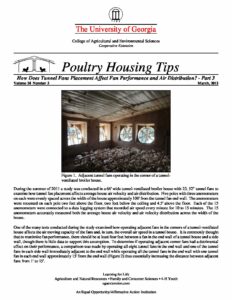During the summer of 2011 a study was conducted in a 66' wide tunnel-ventilated broiler house with 23, 52" tunnel fans to examine how tunnel fan placement affects average house air velocity and air distribution. Five poles with three anemometers on each were evenly spaced across the width of the house approximately 100' from the tunnel fan end wall. The anemometers were mounted on each pole two feet above the floor, two feet below the ceiling and 4.5' above the floor. Each of the 15 anemomete...rs were connected to a data logging system that recorded air speed every minute for 10 to 15 minutes. The 15 anemometers accurately measured both the average house air velocity and air velocity distribution across the width of the house.
One of the many tests conducted during the study examined how operating adjacent fans in the corners of a tunnel-ventilated house affects the air moving capacity of the fans and, in turn, the overall air speed in a tunnel house. It is commonly thought that to maximize fan performance, there should be at least four feet between a fan in the end wall of a tunnel house and a side wall, though there is little data to support this assumption. To determine if operating adjacent corner fans had a detrimental effect on their performance, a comparison was made by operating all eight tunnel fans in the end wall and one of the tunnel fans in each side wall immediately adjacent to the end wall while operating all the tunnel fans in the end wall with one tunnel fan in each end wall approximately 15' from the end wall (Figure 2) thus essentially increasing the distance between adjacent fans from 1' to 15'.
Air velocity measurements indicated that increasing the distance between adjacent corner fans had little effect on the average air velocity in the house (Figure 3). Increasing the distance between adjacent fans from one to fifteen feet increased the average air speed from 448 ft/min to 453 ft/min, an increase of only 5 ft/min. This of course is not to say that the fan performance was unaffected. A decrease in air speed of 5 ft/min in the 66' -wide house represented a decrease in the total air moving capacity of the fans of roughly 3,000 cfm. If we assume the decrease in 3,000 cfm was evenly split amongst the four fans in the corners, which were moving approximately 27,600 cfm, this would indicate that the air moving capacity of the four fans was reduced by roughly 2.7%. This is in close agreement to the findings of Simmons et.al., in 1998 when they conducted a similar study. In their study two, 48" fans (one movable, and one stationary) were placed in adjacent walls of a research broiler house. The air moving capacity of the stationary fan was measured as the movable fan was repositioned at regular decreasing intervals from six to one foot toward the stationary fan. Their testing showed a 2% decrease in the air moving capacity of the stationary fan when the other fan was moved to within a distance of one foot.
Though efforts should be taken when it comes to maximizing tunnel fan performance, it is important to realize that placing tunnel fans in close proximity of the corners in a house should not be a significant concern. If producers want to maximize their bird cooling ability during hot weather they should concentrate their efforts on things that have been proven time and again to have a much more substantial effect on a fan’s ability to move air. Namely, proper fan maintenance. Fan shutters, housing and blades should be cleaned on a regular basis. Fan belts should be replaced yearly and evaporative cooling pads should be throughly cleaned after each flock to insure the fans do not have to work too hard to pull air into a house. By taking these simple measures producers will insure that their fans will continue to produce the maximum amount of air speed thus, insuring maximum bird cooling during hot weather.
Details
| Year | Volume | Number | Categories |
|---|---|---|---|
| 2012 | 24 | 3 |

